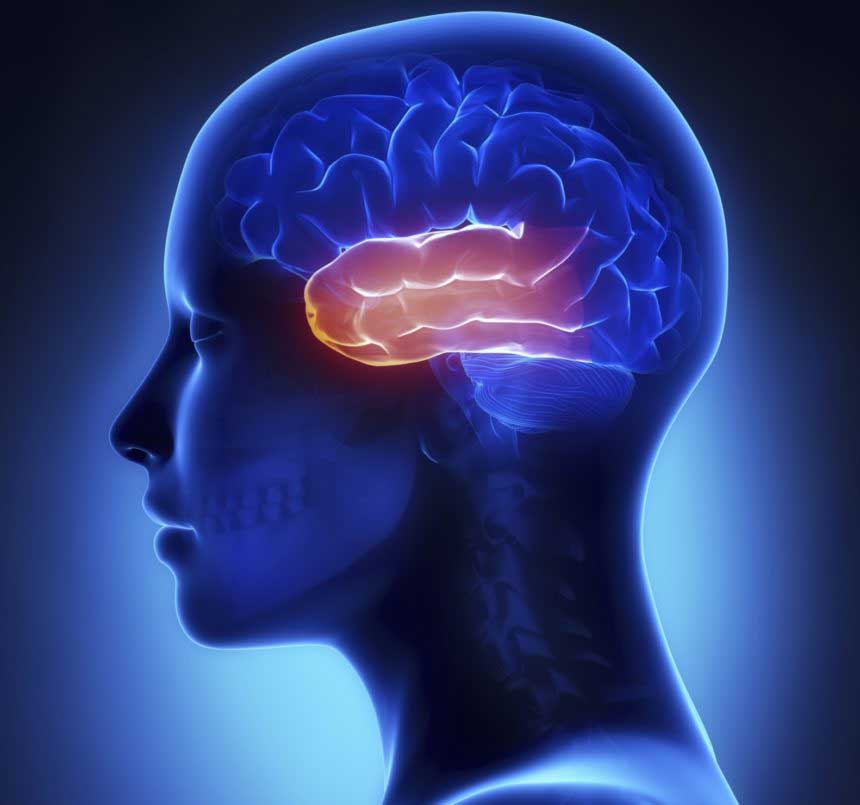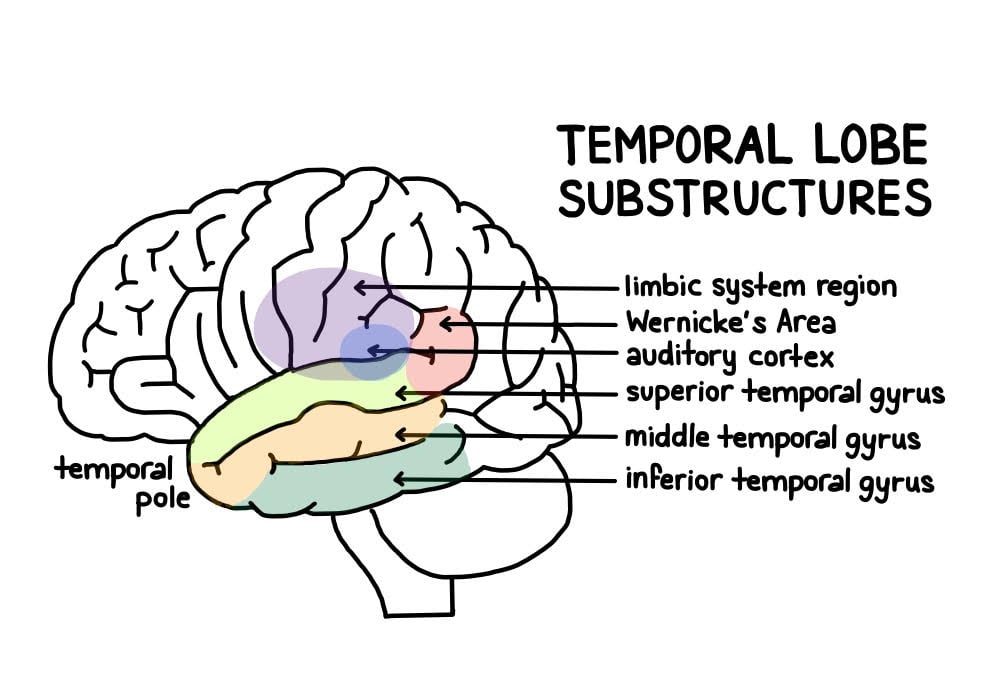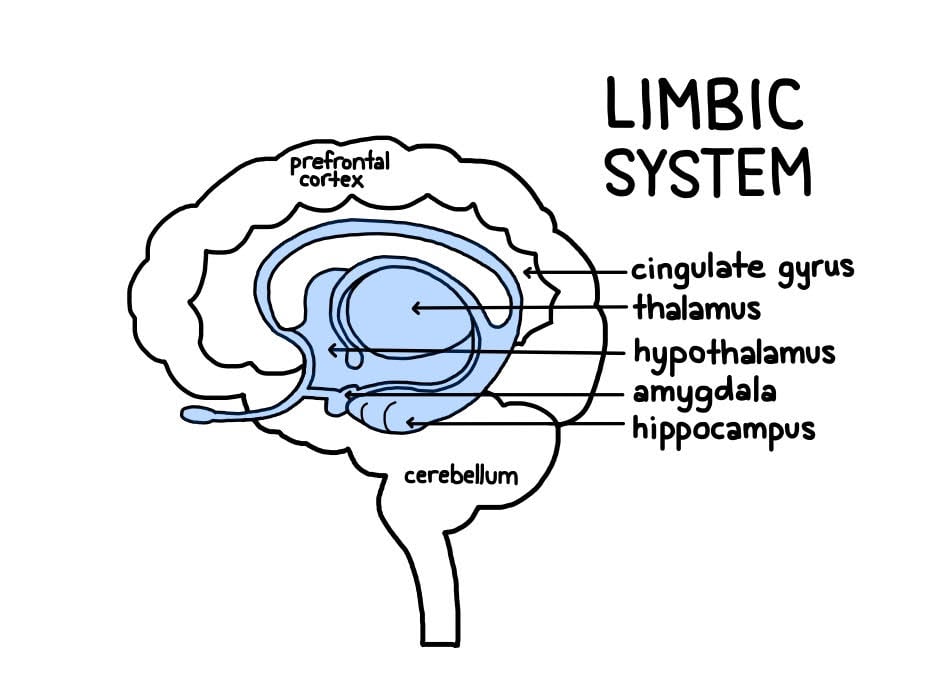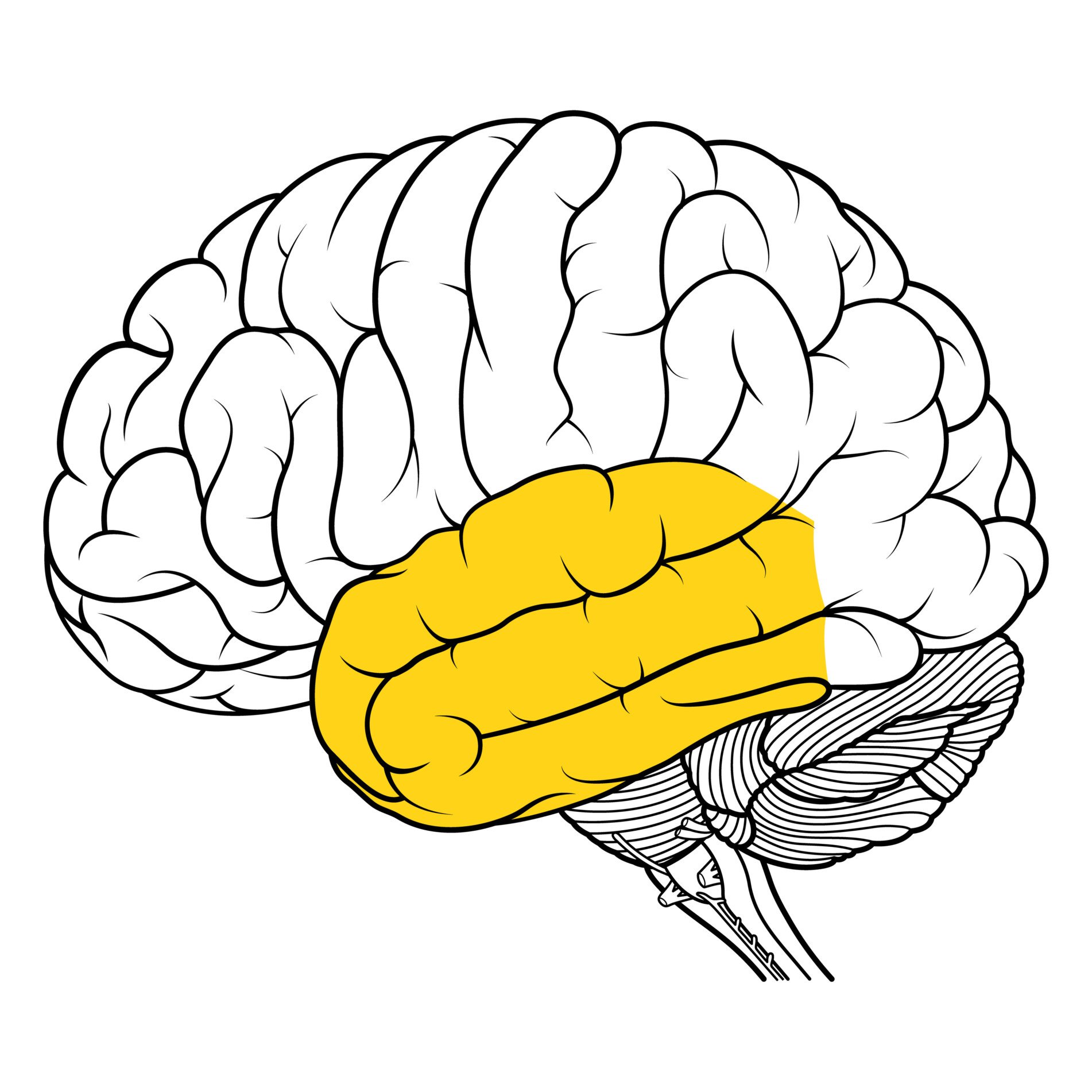On This Page:
The temporal lobe plays a key role in processing auditory information, memory formation, language comprehension, and some aspects of emotion and speech production. It houses structures like the hippocampus, crucial for long-term memory, and the primary auditory cortex, essential for interpreting sounds.
The temporal lobe is the second largest lobe of the human cerebrum, accounting for almost one-fourth of the brain’s overall volume, and is associated with hearing, memory, emotion, and some aspects of language.

The word temporal refers to the temples of the head, which refers to the temporal lobe’s positioning in the cerebrum.
There are many substructures within the temporal lobe which have specific functions. The innermost part of the temporal lobe, known as the limbic system, includes the hippocampus and the amygdala.
Functions
The main functions of the temporal lobe include understanding language, memory acquisition, face recognition, object recognition, perception, and processing auditory information.
Like the other lobes of the brain, there are left and right temporal lobes in both cerebral hemispheres. The right and left temporal lobes transmit information to each other and other lobes through several structures of the brain including the corpus callosum.
Essentially, the temporal lobes interact with and depend upon input, which can be from other brain regions, as well as from sensory input from the environment. Of possible sensory inputs, the temporal lobe mainly processes auditory and visual signals.
Because the temporal lobe is implicated in auditory processing, it is also involved in language processing, which is how we interpret what others say to us and how we produce language.
The temporal lobes are also vital for declarative and long-term memory.
However, the specific roles can vary among individuals, especially between left-handed and right-handed people.
Differences in functionality between the right and left temporal lobes can be generalized in the context of the lateralization of brain function, with most people having the Wernicke’s area localized to their left temporal lobe.
Left Temporal Lobe
The left temporal lobe, typically the most dominant in people, is associated with understanding language, learning, memorizing, forming speech, and remembering verbal information.
- Auditory Processing: It processes auditory information, deciphering sounds and speech.
- Language Comprehension: One of its most well-known regions is Wernicke’s area, critical for understanding spoken language.
- Verbal Memory: It’s involved in retaining and recalling verbal information and facts.
- Speech Production: While Broca’s area (located in the frontal lobe) is primary for speech production, the left temporal lobe contributes to the formulation and coherence of speech.
- Music Perception: Especially the early stages of processing melodies.
- Emotional Response: It plays a role in interpreting and producing emotional responses, especially those linked to language.
Right Temporal Lobe
The right temporal lobe, typically the least dominant in people, is associated with learning and memorizing non-verbal information (e.g., drawings and music), recognizing information, and determining facial expressions.
- Auditory Processing: Like the left temporal lobe, it processes auditory information.
- Visual Memory: It helps recognize and process visual stimuli, particularly complex visual patterns.
- Processing of Non-verbal Sounds includes recognizing different tones or pitches and understanding environmental sounds.
- Emotional Processing: The right temporal lobe plays a role in processing emotions and understanding the emotional content in sounds, such as the emotional tone in a person’s voice.
- Facial Recognition: It is particularly involved in recognizing and interpreting faces.
- Spatial Processing: This involves understanding spatial orientation and the layout of scenes.
Substructures of the Temporal Lobes
The temporal lobe is structurally divided into the superior, middle, and inferior gyri.

Superior Temporal Gyrus
‘Superior’ in anatomical terms means ‘to the top.’ A ‘gyrus’ (or plural: gyri) is a ridge on the surface of the brain.
The superior temporal gyrus is situated at the top of the temporal lobes, located somewhat above the ears. The superior temporal gyrus is an area of the temporal lobe that contains other areas with specialized functions.
Some areas of the superior temporal gyrus are vital in auditory processing, including the processing of language. Other areas are specialized for processing a combination of frequencies, whilst others specialize in processing changes in amplitude or frequency.
The superior temporal gyrus has been implicated as being critical in social cognition (Jou, Minshew, Keshaven, Vitale, & Harden, 2010), as well as being involved in the perceptions of emotions from facial expressions (Radua et al., 2010).
Wernicke’s Area
Wernicke’s area is believed to be situated in the posterior part of the temporal lobe, frequently found in the left hemisphere.
It takes its name from Carl Wernicke, who worked with patients who had language impairments in order to distinguish separate regions for language comprehension and production.
Wernicke’s area is particularly important for language development as well as the comprehension of speech, giving meaning to speech, and the written word.
Auditory Cortex
The auditory cortex, the main area responsible for processing auditory information, is located within the temporal lobe.
The auditory cortex is part of the superior temporal gyrus, which essentially receives input from the ears through the brainstem and processes it.
Once it has done this, the auditory cortex relays the relevant information to be processed and understood.
The sensory information that is received gets processed into meaningful units such as speech and words. As well as being able to do this, the signals can be transmitted back to the ears and can be interconnected with other parts of the cerebral cortex.
This area of the temporal lobes is therefore responsible for processing auditory information, especially important in processing the semantics in language and vision.
The auditory cortex is also important for performing basic and higher functions in regard to hearing, as well as being essential for the ability to switch languages.
Limbic System
The temporal lobe is a significant part of the limbic system. The limbic system is a group of structures deep within the brain involved in processing and regulating emotions, memory, and motivation.

One of the substructures, the hippocampus, is a seahorse-shaped area essential in the formation of new memories.
The hippocampus is important for the early storage of long-term memories and is involved in the transition of long-term memory to even more permanent memory. Early information about the hippocampus’s function was gathered from instances of hippocampus lesions or resections, as with Patient H.M., whose bilateral medial temporal lobe resection (including the hippocampus) prevented him from forming new memories.
Another substructure of the limbic system, the amygdala, is known as the emotional center of the brain. The amygdala is involved in processing emotions, fear, and reward, as well as playing a role in the fight-or-flight response.
The amygdala is involved in the modulation of memory strengthening, especially emotional memories. In essence, the stronger the emotional arousal of a memory, the more likely it will be retained.
What Happens if the Temporal Lobe is Damaged?
Below is a list of symptoms that can be associated with damage to the temporal lobes:
- Walking unsteadily
- Impaired verbal and non-verbal memory.
- Impaired speech and understanding of speech – Wernicke’s aphasia.
- Difficulty with executive functions – e.g. planning and coordinating.
- Impaired music skills.
- Inability to recognize faces – prosopagnosia.
- Poor impulse control or addiction.
- Hallucinations – visual, auditory, and olfactory.
- Apathy.
- Deafness.
- Impaired learning.
- Differences in automatic behaviors – e.g. hunger, thirst, and sexual desire.
- Amnesia.
- Aggressive behaviors.
- Difficulty with planning and direction.
- Long and short-term memory loss.
Diagnosis
In order to diagnose damage to the temporal lobes, a thorough history of the symptoms being experienced need to be investigated. This assessment can be accompanied by someone who knows the patient well and has witnessed the problems at hand.
A common cause of temporal lobe damage is epilepsy, so a discussion of previous seizure activity can be discussed.
A referral to a neuropsychologist may be necessary to enable an understanding of the precise nature of the problem and to help with managing the condition.
There are also some common tests that are used to test for temporal lobe function. There is the Rey-Complex Figure which is a test for visual memory. The Wechsler Memory Scale-Revised is also a common test used to assess the verbal memory of an individual.
Further tests, including using magnetic resonance imaging (MRI) or functional MRI (fMRI), can also be used to identify underlying causes by visualizing the temporal lobes themselves.
Treatment
In terms of treatment for temporal lobe damage, especially when it comes to temporal lobe seizures, medication is an option for controlling seizure activity.
A doctor may prescribe one or more drugs and different dosages over a period of months to find the best approach for the patient.
There is also the option of electrical brain stimulators for controlling temporal lobe seizures if medication has proven to be ineffective.
A vagus nerve stimulator is implanted under the skin of the chest and attached to the vagus nerve in the neck to deliver brief intermittent electrical bursts to the brain to reduce seizure activity.
A responsive neurostimulation device, which is another stimulator, monitors brain wave activity and delivers electrical bursts to the brain to stop or shorten a seizure.
Young people, especially children, have a higher likelihood that a part of the brain would function in place of a damaged part of the brain – this is called brain plasticity.
Therefore, plasticity may ameliorate some temporal lobe damage. However, plasticity generally decreases with age, meaning that younger people are more likely to recover from temporal lobe damage than those who are older.
Research Studies
- Vander Ghinst et al. (2016) found that the superior temporal gyrus (STG) may play a functional role in the ‘ cocktail party effect ’- the ability to focus auditory attention on a particular stimulus whilst filtering out other auditory stimuli.
- The researchers conducted magnetoencephalography (MEG) scans on participants exposed to five different listening conditions to test this.
- Jung-Beeman et al. (2004) used functional magnetic resonance imaging (fMRI), discovering that there was STG activity when experiencing insight-based problem solving (also known as the ‘Aha!’ moment).
- Vannucci (2003) also used functional neuroimaging to confirm the role of the medial (middle) temporal lobe in functions involving lexical-semantic processing.
- Squire, Stark, & Clark (2004) found that the medial temporal lobe’s primary function is in memory.
- Milner (1968) studied lesions of the temporal lobes and found significant differences in damage between the left and right hemispheres.
- It was found that lesions in the left temporal lobe resulted in decreased recall of verbal and visual content, including speech perception. In contrast, lesions in the right temporal lobe resulted in decreased recognition of familiar faces, tonal sequences, and some musical abilities.
- Other studies of lesions conclude that left-side lesions result in impaired memory of verbal material and impaired recall of non-verbal material (e.g., music and drawings) in right-side lesions.
- Studies have also suggested that lesions in the temporal lobes are responsible for hearing and perception disorders, dizziness, and hallucinations.
- Allone et al. (2017) found that temporal lobe epilepsy (a common type of epilepsy) has been shown to affect aspects of memory, executive functions, and language difficulties.
- Blumer (1975) found that seizure activity in the temporal lobes can cause paranoia, aggressive behavior, and perseverative speech.
- Blumer & Walker (1975) found that severe damage to the temporal lobes can alter the sexual behavior of individuals, usually that there will be an increase in sexual activity.
- Milner (2003) found that the inferior (lower) temporal cortex is responsible for visual perception. Therefore, lesions in this area can lead to an inability to recognize faces (also known as prosopagnosia).
- There may be a link between the temporal lobes and dyslexia. As dyslexia affects reading ability and gives meaning to language, people with dyslexia may have reduced activity in their left temporal lobes.
- Valdois et al. (2019) found that impaired attentional systems within the temporal lobes can be associated with developmental dyslexia.
- Lowndes & Savage (2007) proposed that the earliest neuropsychological identification of Alzheimer’s disease may lie in the medial temporal lobe.
- Due to the superior temporal sulcus’ (STS) role in interpreting social and speech input, Redcay (2008) suggested that impairments in STS function may underlie many of the social and language difficulties in those with Autism Spectrum Disorders.
- Kasai et al. (2003) used neuroimaging techniques on patients with Schizophrenia and found structural abnormalities in their superior temporal gyrus.
- There may also be a link between auditory cortex damage/deficits and schizophrenia, as damage in this area is linked to major symptoms of schizophrenia (e.g. hearing voice and auditory hallucinations).
References
Allone, C., Buono, V. L., Corallo, F., Pisani, L. R., Pollicino, P., Bramanti, P., & Marino, S. (2017). Neuroimaging and cognitive functions in temporal lobe epilepsy: a review of the literature. Journal of the neurological sciences, 381, 7-15.
Blumer, D. (1975). Personality changes with frontal and temporal lobe lesions. Psychiatric aspects of neurologic disease, 1, 151-170.
Blumer, D., & Walker, A. E. (1975). The neural basis of sexual behavior. Psychiatric aspects of neurological disease . New York: Grune & Stratton, 199-217.
Jou, R. J., Minshew, N. J., Keshavan, M. S., Vitale, M. P., & Hardan, A. Y. (2010). Enlarged right superior temporal gyrus in children and adolescents with autism. Brain research, 1360, 205–212.
Jung-Beeman, M., Bowden, E. M., Haberman, J., Frymiare, J. L., Arambel-Liu, S., Greenblatt, R., Reber, P. J. & Kounios, J. (2004). Neural activity when people solve verbal problems with insight. PLoS Biol, 2 (4), e97.
Kasai, K., Shenton, M. E., Salisbury, D. F., Hirayasu, Y., Lee, C. U., Ciszewski, A. A., Yurgelun-Todd, D., Kikinis, R., Jolesz, F. A. & McCarley, R. W. (2003). Progressive decrease of left superior temporal gyrus gray matter volume in patients with first-episode schizophrenia. American Journal of Psychiatry, 160 (1), 156-164.
Lowndes, G., & Savage, G. (2007). Early detection of memory impairment in Alzheimer’s disease: a neurocognitive perspective on assessment. Neuropsychology review, 17(3), 193-202.
McDonald, C., Giampietro, V., Brammer, M. J., David, A. S., & Surguladze, S. A. (2010). Neural response to specific components of fearful faces in healthy and schizophrenic adults. NeuroImage, 49 (1), 939–946.
Milner, B. (1968). Visual recognition and recall after right temporal-lobe excision in man. Neuropsychologia, 6 (3), 191-209.
Milner, B. (2003). Visual recognition and recall after right temporal-lobe excision in man. Epilepsy & Behavior, 4 (6), 799-812.
Redcay, E. (2008). The superior temporal sulcus performs a common function for social and speech perception: implications for the emergence of autism. Neuroscience & Biobehavioral Reviews, 32 (1), 123-142.
Squire, L. R., Stark, C. E., & Clark, R. E. (2004). The medial temporal lobe. Annu. Rev. Neurosci., 27, 279-306.
Temporal Brain Lobe. (2020: November 25). The Human Memory. https://human-memory.net/temporal-brain-lobe/
Tidy, C. (2016, September 29). Temporal Lobe Lesions. Patient. https://patient.info/doctor/temporal-lobe-lesions-pro#
Valdois, S., Lassus-Sangosse, D., Lallier, M., Moreaud, O., & Pisella, L. (2019). What bilateral damage of the superior parietal lobes tells us about visual attention disorders in developmental dyslexia. Neuropsychologia, 130, 78-91.
Vander Ghinst, M., Bourguignon, M., de Beeck, M. O., Wens, V., Marty, B., Hassid, S., Choufani, G., Jousmaki, V., Hari, R., Van Bogaert, P, Goldman, S. & De Tiege, X. (2016). Left superior temporal gyrus is coupled to attended speech in a cocktail-party auditory scene. Journal of Neuroscience, 36 (5), 1596-1606.
Vannucci, M., Dietl, T., Pezer, N., Viggiano, M. P., Helmstaedter, C., Schaller, C., Elger, C. E. & Grunwald, T. (2003). Hippocampal function and visual object processing in temporal lobe epilepsy. Neuroreport, 14 (11), 1489-1492.


